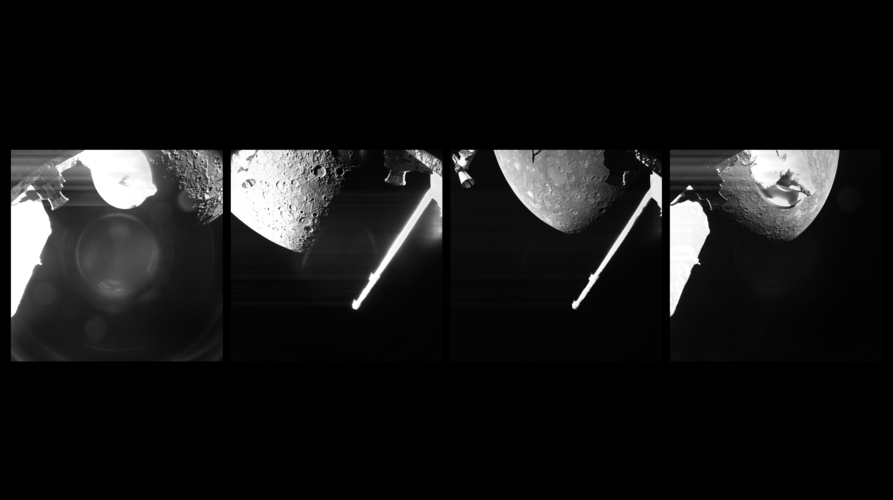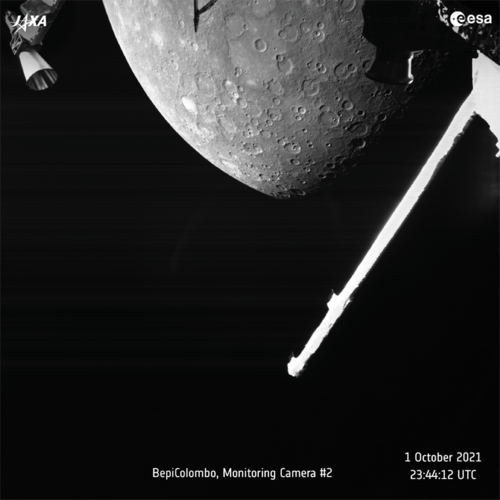
Copernical Team
Europe-Japan space mission captures images of Mercury
 The European-Japanese BepiColombo spacecraft has sent back its first images of Mercury, the nearest planet to the Sun, the European Space Agency said Saturday.
The images were obtained almost three years after the unmanned mission vessel was launched aboard an Ariane 5 Rocket.
The cameras attached the BepiColombo provided black-and-white images, the ESA said in a statement.
But as th
The European-Japanese BepiColombo spacecraft has sent back its first images of Mercury, the nearest planet to the Sun, the European Space Agency said Saturday.
The images were obtained almost three years after the unmanned mission vessel was launched aboard an Ariane 5 Rocket.
The cameras attached the BepiColombo provided black-and-white images, the ESA said in a statement.
But as th Dust collected from a speeding asteroid analyzed with massive accelerator
 It's not uncommon for scientists to bring interesting objects thousands of miles to Argonne National Laboratory for study. But it's fair to say that the latest of these to land at the laboratory came from much, much farther away.
A team of scientists with Argonne and the University of Chicago is among the few groups around the world chosen to study tiny fragments of an asteroid. These dust
It's not uncommon for scientists to bring interesting objects thousands of miles to Argonne National Laboratory for study. But it's fair to say that the latest of these to land at the laboratory came from much, much farther away.
A team of scientists with Argonne and the University of Chicago is among the few groups around the world chosen to study tiny fragments of an asteroid. These dust Study finds evidence of the origin of metal-rich near-earth asteroids
 Little is known about the population of metal-rich Near-Earth Asteroids (NEAs), their number, origin, and relationship with meteorites found on Earth. A new paper by Planetary Science Institute Associate Research Scientist Juan Sanchez explains how near-infrared spectroscopic data of two NEAs reveals new information about the composition and physical properties of these bodies.
"We find th
Little is known about the population of metal-rich Near-Earth Asteroids (NEAs), their number, origin, and relationship with meteorites found on Earth. A new paper by Planetary Science Institute Associate Research Scientist Juan Sanchez explains how near-infrared spectroscopic data of two NEAs reveals new information about the composition and physical properties of these bodies.
"We find th NASA plans careful restart for Mars helicopter after quiet period
 The Mars helicopter Ingenuity is on its own without NASA's guidance for two weeks as the sun interferes with communications to the Red Planet.
Sometime around Oct. 14, NASA plans to check in with the helicopter and the Mars rover Perseverance. Previous rovers have endured so-called solar conjunction communication dropouts, but never has a tiny aircraft sat alone on the planet for so lon
The Mars helicopter Ingenuity is on its own without NASA's guidance for two weeks as the sun interferes with communications to the Red Planet.
Sometime around Oct. 14, NASA plans to check in with the helicopter and the Mars rover Perseverance. Previous rovers have endured so-called solar conjunction communication dropouts, but never has a tiny aircraft sat alone on the planet for so lon NASA TV coverage set for Russian film production mission launch
 NASA will provide coverage of a Tuesday, Oct. 5 launch that will carry a Russian cosmonaut, actress, and film producer to the International Space Station, where they will film segments for a movie. The launch will mark the expansion of commercial space opportunities to include feature filmmaking.
Making his fourth flight into space, Roscosmos cosmonaut Anton Shkaplerov will join actress Yu
NASA will provide coverage of a Tuesday, Oct. 5 launch that will carry a Russian cosmonaut, actress, and film producer to the International Space Station, where they will film segments for a movie. The launch will mark the expansion of commercial space opportunities to include feature filmmaking.
Making his fourth flight into space, Roscosmos cosmonaut Anton Shkaplerov will join actress Yu BepiColombo swings by Mercury ahead of 2025 orbital insertion
 The joint European-Japanese BepiColombo mission captured this view of Mercury on 1 October 2021 as the spacecraft flew past the planet for a gravity assist manoeuvre.
The image was taken at 23:44:12 UTC by the Mercury Transfer Module's Monitoring Camera 2, when the spacecraft was about 2418 km from Mercury. Closest approach of about 199 km took place shortly before, at 23:34 UTC. In this v
The joint European-Japanese BepiColombo mission captured this view of Mercury on 1 October 2021 as the spacecraft flew past the planet for a gravity assist manoeuvre.
The image was taken at 23:44:12 UTC by the Mercury Transfer Module's Monitoring Camera 2, when the spacecraft was about 2418 km from Mercury. Closest approach of about 199 km took place shortly before, at 23:34 UTC. In this v BepiColombo’s first views of Mercury

The ESA/JAXA BepiColombo mission has captured its first views of its destination planet Mercury as it swooped past in a close gravity assist flyby last night.
'Mini psyches' give insights into mysterious metal-rich near-Earth asteroids

Metal-rich near-Earth asteroids, or NEAs, are rare, but their presence provides the intriguing possibility that iron, nickel and cobalt could someday be mined for use on Earth or in Space.
New research, published in the Planetary Science Journal, investigated two metal-rich asteroids in our own cosmic backyard to learn more about their origins, compositions and relationships with meteorites found on Earth.
These metal-rich NEAs were thought to be created when the cores of developing planets were catastrophically destroyed early in the solar system's history, but little more is known about them.
Space archaeology study: Life & culture on the International Space Station

In an out of this world study, space archaeologists are reconstructing life on the International Space Station (ISS) over the past two decades, to better understand space culture and get an inside look at how astronauts interact with their tools and colleagues when above Earth.
The ability to understand the 'microsociety' of crews onboard the ISS will offer a window into how life in space functions, as humans consider interplanetary exploration. So how is this gravity defying research made possible?
Internationally recognized space archaeologist, Associate Professor Alice Gorman at Flinders University, says ISS researchers won't be able to travel to the space station themselves, instead opting to use millions of photographs taken onboard over nearly two decades, to document developments and changes within the station's lifestyle and cultural makeup.
"Fortunately for us, the first occupation of the ISS coincided with the emergence of digital photography," says Associate Professor Gorman.
"The images include metadata recording the time and date, which become an excavation, linking the contents of images to moments in time. Given that the crew takes approximately 400 photographs per day, images depicting the station interior now number in the millions.


 Image:
Hello Mercury
Image:
Hello Mercury